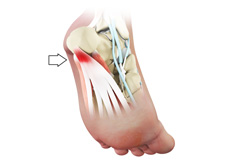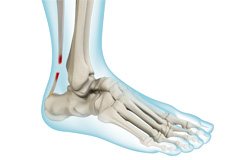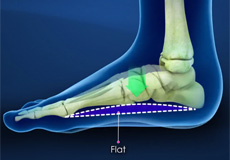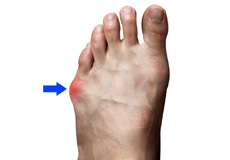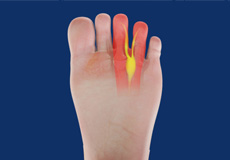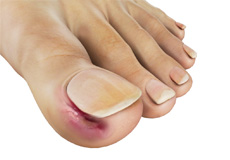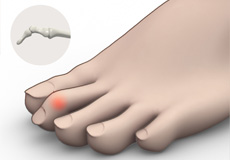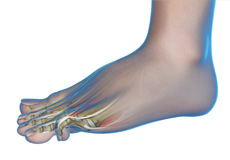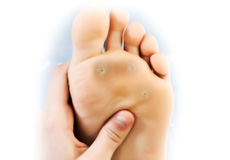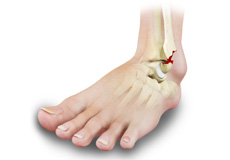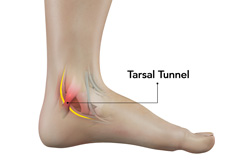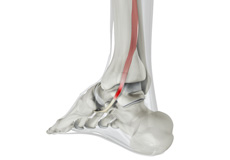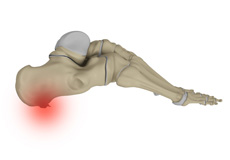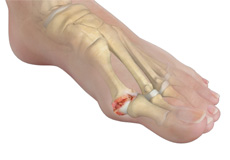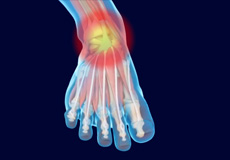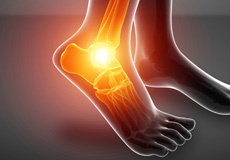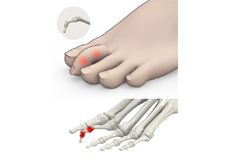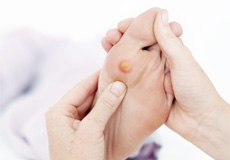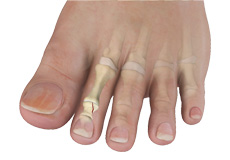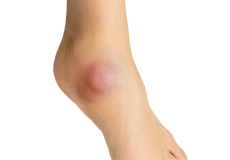- Anatomy
- Conditions
- Procedures
-
Posterior Heel Pain
Pain, aching, or stiffness on the bottom of the heel is a common ailment. The most common explanation of this condition is plantar fasciitis, which is an inflammation of the fascia on the bottom of the foot. However, there are several other possible explanations as well. This article will briefly describe and discuss other causes of heel pain.
-
Achilles Tendinitis and Rupture
The Achilles tendon is named for the Greek hero Achilles, who was dipped in a river by the gods to make him indestructible. But where he was held – at the back of his ankle – the river water did not touch. And this was his only weakness – his Achilles heel. Although Achilles died when struck by an arrow in his heel, Achilles tendinitis and rupture is not life threatening. But it can be quite painful and debilitating.
-
Pediatric Foot Conditions
Coming soon
-
Bunions
Bunions on feet are bony prominences at the base of the big toe. Bunions on the outside of the foot, at the base of the little toe, is called a bunionette, or tailors bunion.
-
Neuromas
Morton’s neuroma refers to a nerve injury that occurs between the toes, usually the third and fourth toes. This causes pain and thickening of the nerve tissue.
-
Ankle Sprain
Ankle injuries tend to result from when your foot turns in on itself. This injury stretches and weakens the ligaments that bridge the ankle and foot bones. Ankle injuries are the most common athletic injuries. The condition is usually defined according to the extent of the damage suffered by the ligament.
-
Rheumatoid Arthritis
Rheumatoid arthritis (RA) is a chronic inflammatory disease that causes pain, stiffness, and swelling in the joints, frequently symmetrical (if one foot has it, the other one will). In RA, the joint lining (synovium), normally smooth and shiny, becomes inflamed, painful and swollen. The disease, which lasts over a long period of time, can cause damage to cartilage, bone, tendons and ligaments.
-
Ingrown Toenail
Millions of people in America alone suffer from ingrown toenails. An ingrown toenail most commonly affects the big toe, known anatomically as the Hallux. When an ingrown toenail occurs, the nail grows abnormally into the skin and flesh of the toe. This leads to pain and the overgrowth of skin tissue at the side of the nail.
-
Mallet Toe
In mallet toe, the joint at the end of the toe, known anatomically as the DIP joint, is the one that buckles. Unlike in hammer toe, which is the skin near the toenail develops a corn that is painful and may ulcerate. The other joint remains relatively normal.
-
Hammer Toe
Hammer toe is caused by an inherited muscle imbalance or abnormal bone length. It may occur in children who outgrow their shoes rapidly. In this condition one or more small toes buckle when the middle joint (the PIP joint) contracts. This causes the tendons to shorten.
-
Plantar Warts
The foot is a highly mechanical apparatus, and it carries the entire weight of the body when we stand, walk, and run. Several common conditions—warts, corns, and metatarsalgia—often cause pain and contribute to a loss of function in the use of the foot. Failure to treat these conditions may contribute to the development of serious and disabling changes to the foot.
-
Stress Fracture Leg and Foot
A fracture (or broken bone) is a disruption, or break, in a bone. Some fractures, called stress fractures, are microscopic, and because they are not displaced (when the bone has shifted its position), they cannot initially be seen on regular x-rays. After time and healing starts to occur, the bone repair process shows up. Stress fractures occur as a result of repetitive overuse.
-
Tarsal Tunnel Syndrome
Tarsal tunnel syndrome is a condition analogous to carpal tunnel syndrome, with the former condition affecting the foot, and the latter affecting the wrist. The tarsal tunnel is bounded by the ankle bone on one side and a band of fibrous tissue, called the flexor retinaculum, on the other. The main nerve serving the foot, the posterior tibial nerve, runs through this tube, or tunnel.
-
Posterior Tibial Dysfunction (Acquired Flatfoot)
When someone loses the function of his or her posterior tibialis tendon (a tendon that passes under the ankle and lifts the arch of your foot), he or she will most likely develop posterior tibial dysfunction. The tendon can tear from injury, can suffer from tendinitis, or can include muscle dysfunction. Once the tendon is damaged, the result will often be a loss of support for the foot's arch and a flat foot deformity.
-
Plantar Fasciitis (Heel Spurs)
Although some experts distinguish between the terms plantar fasciitis and heel spurs, others do not, and the distinction is difficult to make, especially for a non-specialist. We will use the terms interchangeably.
-
Hallux Rigidus (Stiff Big Toe)
Hallux Rigidus, toe pain, sometimes called "stiff big toe," is a commonly occurring condition of degenerative arthritis (a wearing out of surfaces) affecting the MTP joint, the large joint at the base of the great (big) toe, the hallux. The condition results over time from constant wear and stress or from an injury to the joint. The result of the condition is pain, swelling, and/or restriction of movement; eventually the patient will stop bending the joint when transferring weight to the other foot, as in walking or running.
-
Chronic Lateral Ankle Instability
After treatment, a significant percentage (probably between 20% and 30%) of patients who have suffered lateral ankle ligament injury (see Ankle Sprain) experience chronic (frequent or persistent) ankle pain, stiffness, or swelling, or even instances of the ankle "giving way" (a sudden failure to support the body weight) when walking or standing. Chronic lateral ankle instability is a common problem among many athletes.
-
Chronic Leg Pain
Usually affecting athletes (particularly runners), chronic leg pain can be a dull, nagging pain or a sharp, intense pain. The most likely causes of leg pain are stress fractures, chronic compartment syndrome (when bleeding and swelling get in the way of proper circulation of the muscle and nerve tissues), medial tibial stress syndrome ("shin splints"– inflammation of muscle near the tibia), and nerve entrapments. Chronic leg pain can also be called "shin splints," "periostitis," "stress fracture," and "acute compartment syndrome".
-
Claw Toe
A claw toe, hammer toe, or mallet toe is a toe that is bent at both the middle and end joints in the toe, known anatomically as the DIP and PIP joints, and a dorsiflexion (a muscle that causes backward flexion) deformity at the metatarsal phalangeal joint. This condition can lead to severe pressure and pain. It is similar anatomically to bunions because both are a result of weak muscles that cause a deformity to the bone. Hammertoes occur in the four smaller toes, and because they all tend to be affected, the condition is sometimes known as 'claw foot.'
-
Corns and Metatarsalgia
When a corn develops on the sole of the foot, it is associated with metatarsalgia, a general term for pain in the sole or ball of the foot. The metatarsal joints are the joints of the bones in the foot, and when they are injured in some way the result is often difficulty or pain in the foot while walking or standing.
-
Fracture of the Phalanges
A fracture (or broken bone) is a disruption, or break, in a bone. Some fractures, called stress fractures, are microscopic, and restricting activity on the limb that is broken can usually treat these.
-
Ganglion Cysts & Plantar Fibromas
A ganglion cyst refers to a single tissue mass (bump, tumor) under the skin over joints or tendons of the foot, wrist, fingers, and other parts of the body. They contain a clear, viscous, gelatinous fluid and are almost always benign (not cancerous). Although they can be painless, they are usually associated with tenderness and pain that can restrict movement. The mass of the plantar fibromatosis appears on the sole of the foot on the plantar fascia.

